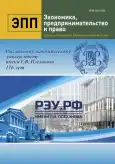International transport corridors and their impact on national economic development
- Authors: Sharova I.V.1, Golova D.V.1
-
Affiliations:
- Plekhanov Russian University of Economics
- Issue: Vol 13, No 4 (2023)
- Pages: 1153-1164
- Section: Articles
- URL: https://journals.eco-vector.com/2222-534X/article/view/607630
- DOI: https://doi.org/10.18334/epp.13.4.117486
- ID: 607630
Cite item
Abstract
The article discusses the concept, goals of creation and general characteristics of international transport corridors. The authors provide a brief description of the prerequisites for the formation and development of international transport corridors. From the point of view of micro and macro economic indicators, the contribution of international transport corridors to the development of the national economy of the member states of the transport system is considered. Conclusions about the importance of international transport corridors for the economy of the state can be used in the future to assess the need for the development of transport and logistics infrastructure within the framework of already functioning international transport corridors, to identify new strategic directions for the formation of new international transport corridors in the context of changing macroeconomic prerequisites and the redistribution of transport flows amidst sanctions, as well as to assess the prospects for the formation of new transport corridors. The article may be of interest to researchers of global and regional economics, transport and logistics, international entrepreneurship and public administration.
About the authors
Irina Vladimirovna Sharova
Plekhanov Russian University of Economics
Email: Sharova.IV@rea.ru
Dmitriy Vasilevich Golova
Plekhanov Russian University of Economics
Email: dmitrygolova@gmail.com
References
- Бирюков П.Э. Международные транспортные коридоры в условиях формирования нового мироустройств. / Дис. канд. полит. наук. - М., 2021. – 181 c.
- Louis Albrechts, Tom Coppens Megacorridors: Striking a Balance Between the Space of Flows and the Space of Places // Journal of Transport Geography. – 2003. – № 3. – p. 215-224. – doi: 10.1016/S0966-6923(03)00032-2.
- Холопов К.В. Экономика и организация внешнеторговых перевозок. / Учебник. - М.: Юристъ, 2000. – 236 c.
- The United Nations Economic Commission for Europe. Unece.org. [Электронный ресурс]. URL: http://www.unece.org/info/ece-homepage.html/ (дата обращения: 19.01.2023).
- Распоряжение Правительства Российской Федерации от 27.11.2021 № 3363-р «О Транспортной стратегии Российской Федерации до 2030 года с прогнозом на период до 2035 года». Publication.pravo.gov.ru. [Электронный ресурс]. URL: http://publication.pravo.gov.ru/Document/View/0001202112030006 (дата обращения: 19.01.2023).
- European Agreement on main international traffic arteries concluded in Geneva on 15 November 1975. Treaties.un.org. [Электронный ресурс]. URL: https://treaties.un.org/doc/Publication/UNTS/Volume%201539/volume-1539-A-21618-English.pdf (дата обращения: 19.01.2023).
- Вардомский Л.Б., Тураева М.О. Развитие транспортных коридоров постсоветского пространства в условиях современных геополитических и экономических вызовов. - М.: ИЭ РАН, 2018. – 66 c.
- Part II of the Agreement on the European Economic Area concluded on 02 May 1992m. Efta.int. [Электронный ресурс]. URL: https://www.efta.int/Legal-Text/EEA-Agreement-1327 (дата обращения: 22.01.2022).
- International transport corridors in Eurasian space: development of latitudinal routes. Information and analytical digest. [Электронный ресурс]. URL: https://index1520.com/en/analytics/mezhdunarodnye-transportnye-koridory-na-evraziyskom-prostranstve-razvitie-shirotnykh-marshrutov/.
- Комов М.С. Современные тенденции развития и значение международных транспортных коридоров на рынке транспортных услуг // Экономика и предпринимательство. – 2022. – № 6(143). – c. 243-246. – doi: 10.34925/EIP.2022.143.6.044.
- Соглашение о международном транспортном коридоре «Север – Юг» между Правительством Российской Федерации, Правительством Республики Индия, Правительством Исламской Республики Иран и Правительством Султаната Оман, совершенное 12 сентября 2000 года. Pravo.gov.ru. [Электронный ресурс]. URL: http://pravo.gov.ru/proxy/ips/?doc_itself=collection=1nd=201014134page=1rdk=0link_id=9#I0 (дата обращения: 21.01.2023).
- Газета «Коммерсантъ». [Электронный ресурс]. URL: https://www.kommersant.ru/doc/256473 (дата обращения: 24.01.2023).
- Maria Demertzis, Benjamin Hilgenstock, Ben McWilliams, Elina Ribakova, Simone Tagliapietra How have sanctions impacted Russia?. Bruegel.org. [Электронный ресурс]. URL: https://www.bruegel.org/policy-brief/how-have-sanctions-impacted-russia (дата обращения: 12.01.2023).
- Федеральная таможенная служба Российской Федерации. [Электронный ресурс]. URL: https://customs.gov.ru/press/pressa-o-nas/document/376199 (дата обращения: 27.01.2023).
- Цыденов А.С. Роль международных транспортных коридоров в процессе интеграции России в мировую экономику // Государство и транспорт. – 2014. – № 2(51). – c. 3-8.
- Левитин Е.И. Развитие транспортной системы и экономический рост регионов (на примере транспортного коридора «Запад — Восток») // Транспортные коридоры в инновационном развитии экономике регионов: Материалы международной научно-практической конференции. М., 2009. – c. 7-10.
Supplementary files









